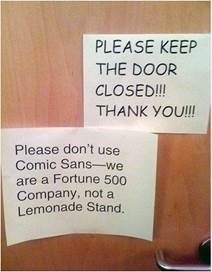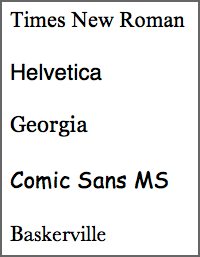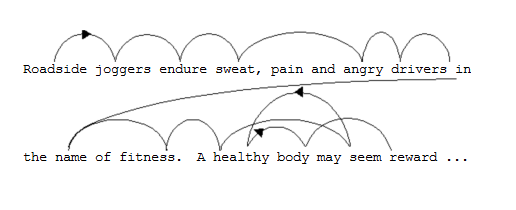
By Matthew Stibbe, Articulate Marketing
Typography affects your credibility
Errol Morris carried out an experiment on New York Times readers. Presenting the same information in different fonts, he tested how credible it seemed. Roughly 40,000 people responded to his quiz and it turned out that even small differences between apparently similar fonts had a big impact on believability. (Hat tip: The Week.)
The difference between Baskerville and Georgia was a jump of 1.5 percent. Not huge in itself but considering that it takes one click on the font menu to change from one to the other, you can see how important the choice of font is.
1. Dress for the occasion


You wouldn’t wear a onesie to work, so don’t use Comic Sans in business. In fact, Morris says: ‘The conscious awareness of Comic Sans promotes — at least among some people — contempt and summary dismissal.’ Just check out these hilarious logos of famous brands, redone using Comic Sans.

With Comic Sans, it’s not rocket science any more. (Source: CreativePool.)
The only exceptions I’ll admit is if you work in the comic book industry (but I bet they don’t use it either) or if you’re a complete genius who discovered the Higgs Boson, in which case you can do whatever you like.

2. Don’t use BLOCK CAPITALS
We recognise words largely from the shape they make rather than from the collection of shapes of the individual letters in the words, according to Kevin Larson, a researcher in ‘Advanced Reading Technology’ at Microsoft. (Full disclosure: Microsoft is an Articulate client.)
In other words we see this:
Not this:


We see words. Letters, not so much. (Source: Microsoft)
The ascenders and descenders help us differentiate the words. But using ALL CAPS means that these vital clues are eliminated and the only visual difference between the words is their length. It increases the cognitive load on the reader’s brain, as anyone who has read a contract preamble or an internet rant in all-caps will attest.
4. How people read
We don’t read in a continuous flow. Our eyes jump along a line of text like a small child hopping on hot sand in a series of saccades intermingled with short stops called fixations.

How much we take in with each eye fixation. (Source: Wikipedia)
Sometimes we jump back when we miss something or don’t understand it. When this happens, there’s a double risk: you reduce comprehension and your reader may just stop reading altogether. Ouch!

Saccades, fixations and back skips. (Source: Microsoft)
This means you want to avoid things that slow people down or force them to jump back through incomprehension. Typographical speed bumps include:
- Foreign words
- Italic text
- All-caps text
- Long quotations
- Excessive punctuation (one reason why we now write ‘eg’ not ‘e.g.’ etc)
- Unnecessary capitalisation, which is very common in the tech industry
- Acronyms and abbreviations
Related posts
Magazine Training International’s mission is to encourage, strengthen, and provide training and resources to Christian magazine publishers as they seek to build the church and reach their societies for Christ.



